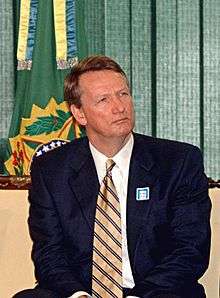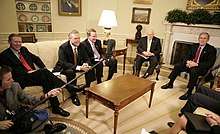Rick Wagoner
George Richard "Rick" Wagoner Jr. (born February 9, 1953) is an American businessman and former chair and chief executive officer of General Motors. Wagoner resigned as chairman and CEO at General Motors on March 29, 2009, at the request of the White House.[1][2][3] The latter part of Wagoner's tenure as CEO of General Motors found him under heavy criticism as the market valuation of GM went down by more than 90% and the company lost more than US$82 billion.[4] This led to him being named one of the worst CEOs of 2008.[5] He is a board member of ChargePoint, an electric vehicle infrastructure company.[6]
Rick Wagoner | |
|---|---|
 Rick Wagoner in 2004 | |
| Born | George Richard Wagoner Jr. February 9, 1953 |
| Nationality | American |
| Alma mater | Harvard Business School Duke University |
| Occupation | Businessman Formerly chairman & CEO of General Motors (2000–2009) |
| Predecessor | John F. Smith Jr. |
Family and education
Wagoner was born in Wilmington, Delaware and grew up in Richmond, Virginia. He graduated from John Randolph Tucker High School there, where he was named "Best All Around" student in his graduating class. He received a BA in Economics from Duke University in 1975.[7] He then attended Harvard Business School, from which he received an MBA in 1977. He is married and has three adult sons.[8]
While at Duke, he became a member of the Delta Tau Delta fraternity. Wagoner is a member of the boards of trustees of Duke University, Detroit Country Day School, the Board of Dean's Advisors of the Harvard Business School, and the board of directors of Catalyst.[9] He is a member of The Business Council, The Business Roundtable, Detroit Renaissance Executive Committee, and the Secretary of Energy Advisory Board.
General Motors
After Harvard, he joined GM as an analyst in the treasurer's office. In 1981, he became treasurer of GM's Brazil subsidiary and later served as managing director.[10]
In 1992, he was named GM's chief financial officer, in 1994 he became executive vice president and/or president of North American Operations, and in 1998 he was named president and chief operating officer.
After GM lost $30 billion during a single three-year stretch in the early 1990s, Wagoner and chairman John F. "Jack" Smith Jr. forced GM "back to basics" to battle "30 years of management mistakes" that left him with little room to maneuver.[11]
Chief Executive Officer

Wagoner became president and chief executive officer in June 2000 and was elected chairman on May 1, 2003. Under his leadership, GM suffered more than $85 billion in losses.
In an interview,[12][13] Wagoner stated that the worst decision of his tenure at GM was "axing the EV1 electric car program and not putting the right resources into hybrids. "It didn't affect profitability," Wagoner claimed, "but it did affect image".[14][15]
In April 2005 Wagoner took back personal control of GM's North American car division from GM North American chairman Bob Lutz and GM North American President Gary Cowger in light of its poor performance.[16] In early June 2005 Wagoner announced that GM in the United States would close several plants and shed 25,000 employees (17% of GM's U.S. workforce) by 2008. The cuts will result in GM production reducing output by one million cars and trucks (from 6 million to 5 million).
In the Automotive industry crisis of 2008–10, Wagoner came under renewed pressure as GM sought financial support from the U.S. government in an attempt to avoid bankruptcy. During the latter half of 2008, Wagoner and GM maintained that bankruptcy was "not an option that GM is considering," despite rapidly running out of capital.[17] This stance was called "presumptuous" by some observers.[18] Within 9 months, GM was to declare bankruptcy.
During hearings for government loans to the Big Three Automakers, Wagoner, Alan Mulally and Robert Nardelli were criticized for flying to Washington, D.C. in corporate jets. For a subsequent meeting, the three CEOs drove from Detroit to Washington by hybrid cars.[19]
The BBC reported that Wagoner was popular among GM employees and reporters. However, it cites that he lacked the "ruthless streak needed to make the tough decisions required to bring GM back from the brink of bankruptcy."[20] While analysts have praised Wagoner for operational improvements, cost-cutting moves and an increased focus on vehicle quality, with the appointment of Bob Lutz to oversee product execution, others criticized him for his incremental approach to change, largely as he resisted making the drastic cuts demanded by that of the market and US government. Throughout the first months of 2009, Wagoner argued that a bankruptcy would be more costly than a government bailout. However, there remained lingering doubts that he was implementing the restructuring moves necessary to remain viable in the future without further government loans.[1][2][3][21][22]
On March 29, 2009, Wagoner agreed to immediately resign his position as GM chairman and CEO, as part of the Obama administration deal to provide GM with further short-term financing. The following day, the US government rejected GM's initial restructuring plan and gave the company 60 days to come with a new proposal or be forced into bankruptcy.[1][2][3][21][22] He was replaced as CEO by Fritz Henderson, who had been serving as GM's President and chief operating officer.
After 32 years at GM, Wagoner retired with an exit package of over $10 million: $1.65 million in benefits per year for his first five years of retirement, $74,030 per year pension for the rest of his life, and a $2.6 million life insurance policy that can be cashed out at any time.[23][24]
In 2017, Wagoner was appointed a director at ChargePoint Inc., a Silicon Valley company that makes electric-vehicle charging stations.[25]
in 2018, Wagoner made an investment into YourMechanic, a Silicon Valley startup which connects owners with a group of certified mechanics, currently offering more than 800 repair services.[26][27]
See also
- Automotive industry crisis of 2008–2009
- General Motors Chapter 11 reorganization
References
- "General Motors Chief Rick Wagoner Said to Step Down (Update3) - Bloomberg L.P."
- Stolberg, Sheryl Gay; Vlasic, Bill (March 30, 2009). "White House Pushes Out G.M. Chief". The New York Times. Retrieved October 4, 2017.
- "GM CEO Wagoner to step down at White House request". Yahoo!. Retrieved October 4, 2017.
- "General Motors bankruptcy: End of an era - Jun. 1, 2009". money.cnn.com. Retrieved January 30, 2020.
- "Worst CEOs of 2008". about.com. Archived from the original on August 10, 2013. Retrieved October 4, 2017.
- Staley, Oliver. "The General Motors CEO who killed the original electric car is now in the electric car business". Quartz. Retrieved October 4, 2017.
- "GM Learns The Price Of Federal Funding". Forbes. March 30, 2008. Retrieved April 17, 2009.
- "Error – LexisNexis Publisher". www6.lexisnexis.com. Retrieved October 4, 2017.
- admin (August 27, 2012). "Board Diversity". catalyst.org. Retrieved October 4, 2017.
- "Rick Wagoner 1953— Biography – An uphill battle, Early years at gm". referenceforbusiness.com. Retrieved October 4, 2017.
- "Rick Wagoner's Game Plan". Bloomberg BusinessWeek. February 10, 2003. Retrieved January 15, 2008.
- "Interview With Rick Wagoner," Motor Trend magazine, June 2006, p. 94
- Canadian Driver, Canadian Driver Archived October 7, 2011, at the Wayback Machine, June 28, 2006
- Naughton, Keith (March 11, 2007). "Why Toyota Is Becoming the World's Top Carmaker". Newsweek. Retrieved December 14, 2016.
- Isidore, Chris (August 6, 2008). "Big Three face bankruptcy fears". CNN. Retrieved December 14, 2016.
- Hakim, Danny (April 5, 2005). "Chief of G.M. Takes Control of Operations". The New York Times. Retrieved December 14, 2016.
- More Cuts Expected at General Motors, "New York Times", July 15, 2008. Retrieved 25 April 2010.
- In Defense of GM's Rick Wagoner, HuffPost, December 8, 2008. Retrieved 25 April 2010.
- Ford's PR campaign: CEO Alan Mulally drives to hearings (no corporate jet), promises $1 salary, Daily News (New York), December 2, 2008. Retrieved 4 December 2008.
- Anderson, Richard (March 30, 2009). "End of the road for Rick Wagoner". BBC News. Retrieved May 22, 2010.
- "GM chief Wagoner ousted by Obama". BBC. March 30, 2009. Retrieved October 4, 2017.
- "GM's Waggoner forced out as automakers' plans rejected". USA Today. Retrieved October 4, 2017.
- Rick Wagoner Gets Over $10 Million, "Huffington Post", August 14, 2009.
- "Ex-GM CEO Gets $10 Million Retirement". www.cbsnews.com. Retrieved January 30, 2020.
- Stoll, John D. (April 6, 2017). "Former GM CEO Rick Wagoner Wades Back Into Car Business". WSJ. Retrieved December 11, 2019.
- "Ex-GM CEO Wagoner invests in Silicon Valley car service startup". Automotive News. October 9, 2018. Retrieved January 30, 2020.
- Szymkowski, Sean (October 10, 2018). "Former GM CEO Rick Wagoner Invests In New Startup Company". GM Authority. Retrieved December 16, 2019.
External links
- Rick Wagoner's biography
- Rick Wagoner's speaks on GM's India strategy
- Rick Wagoner speaks about electric cars at GM in 2008
- Appearances on C-SPAN
| Business positions | ||
|---|---|---|
| Preceded by John F. Smith Jr. |
Chairman General Motors 2003–2009 |
Succeeded by Kent Kresa |
| Preceded by John F. Smith Jr. |
CEO General Motors 2000–2009 |
Succeeded by Frederick Henderson |
| Preceded by John F. Smith Jr. |
President General Motors 1998–2008 |
Succeeded by Frederick Henderson |